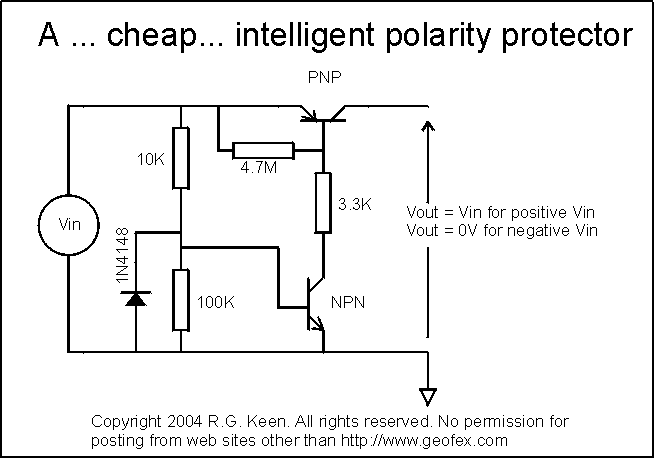|
A cheap - and good - polarity protector |
| Polarity protection is problematic. Every effect needs to
have it, but it needs to NOT suck any of the typically 9V battery
supply.
There are two "conventional wisdom" approaches, both done with a silicon diode. The obvious one is to connect a diode in series with the 9V power. That does the trick, as the diode conducts forwards, powering the circuit, and blocks any reverse voltage. But you lose that 0.6V to the diode, and with old batteries, it can cause bad results. The slightly slyer trick is to place a silicon diode cathode to + and anode to -. That means the diode does not conduct in normal operations, but shorts out the power when power is inadvertently reversed, protecting the circuit. However, what happens when the power supply is not a 9V battery, but an AC power supply? The AC power supply sits there and cooks the diode until the diode shorts, and now you have a dead pedal. If the diode opens, the reverse voltage then kills the circuits on the effect. There are some better ways. The first one was a single MOSFET arranged in a non-standard way to turn on only when the power supply is the right direction, and turn off when the power supply is the wrong direction. GEO brought you that one in 1999, and you can see it under Advanced Power Switching and Polarity Protection. But some people have trouble getting the MOSFETs that are the essence of that approach, or complain about the cost. There is a cheaper way. You can use ordinary bipolar transistors and arrange them to block power if the power is reversed, but pass it if it's proper. The trick is to use the power supply as a signal to the circuit to turn on or off. Here's that one.
The PNP transistor is set up to pass current by having current pulled out of its base. With over 6V to work with, the NPN can pull a lot of current out of the PNP base, and can saturate it down to under 100mv. The 3.3K resistor limits the amount of base current to the PNP. The 10K resistor provides the signal to the NPN to turn on when the Vin power is the correct polarity, and turn off when it's backwards. The 4.7M and 100K resistors help their respective transistors turn off when they're supposed to be off. The 1N4148 diode protects the NPN transistor from damaging reverse base-emitter breakdown. Two transistors - garden variety 2N3904 and 3906 work fine - four resistors and one diode give you low voltage drop series power protection. Hmmm... maybe this ought to be in every effects wrapper... |
